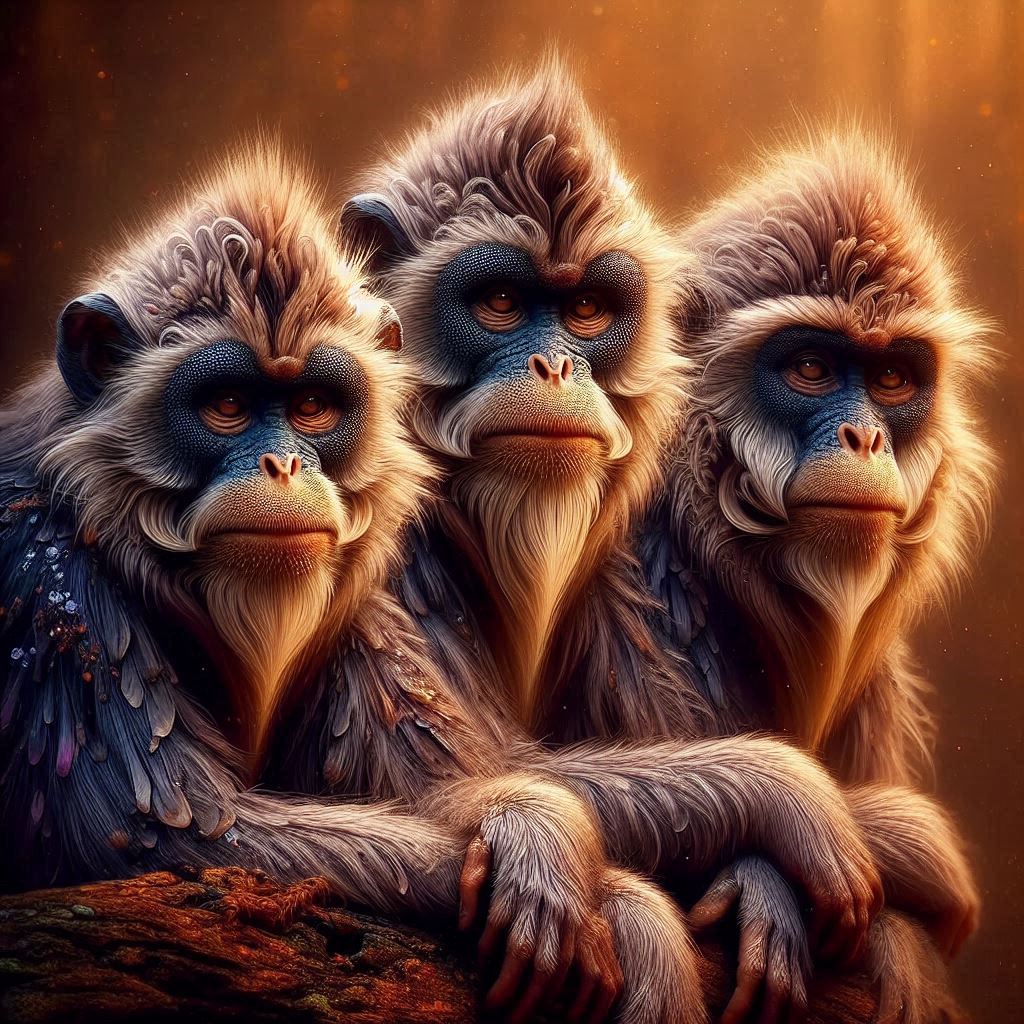
The Most Unique Monkey Species in the World
Share
The Most Unique Monkey Species in the World
Monkeys are some of the most diverse and fascinating animals in the animal kingdom, with hundreds of species exhibiting a wide range of behaviors, appearances, and adaptations. From their vibrant colors to their quirky habits, monkeys never fail to intrigue. But some species stand out more than others for their exceptional characteristics, making them truly unique in the monkey world. Let’s take a closer look at some of the most extraordinary monkey species on Earth!
1. Proboscis Monkey (Nasalis larvatus)
Why It’s Unique:
The proboscis monkey is one of the most distinctive-looking monkeys, thanks to its large, fleshy nose, which is particularly pronounced in males. This unique feature is thought to play a role in attracting mates, with the larger noses signaling greater dominance and fitness.
• Habitat: Found in the rainforests of Borneo, particularly in coastal mangrove forests.
• Diet: Mostly leaves, seeds, and fruit.
• Behavior: Known for their loud honking vocalizations, proboscis monkeys live in groups and are excellent swimmers, often diving into rivers to avoid predators.
2. Golden Lion Tamarin (Leontopithecus rosalia)
Why It’s Unique:
With its striking golden-orange fur, the golden lion tamarin is one of the most visually stunning monkeys. Their mane of fur resembles that of a lion, which is how they got their name. These small monkeys are highly social and often live in family groups.
• Habitat: Native to the coastal rainforests of Brazil.
• Diet: Fruits, insects, and small animals.
• Behavior: Golden lion tamarins communicate with each other using a variety of vocalizations and are known to be extremely agile as they leap from tree to tree in search of food.
3. Mandrill (Mandrillus sphinx)
Why It’s Unique:
Mandrills are known for their vibrant faces, which feature bright blue and red skin around their nose and buttocks. These striking colors are used to signal dominance and social status within their groups. Mandrills are often mistaken for baboons, but they are actually more closely related to the drill monkey.
• Habitat: Found in the rainforests of central West Africa.
• Diet: Fruits, seeds, and small animals.
• Behavior: Mandrills are extremely social and live in large groups. Their colorful faces are a display of strength and health, which helps them form strong social bonds.
4. Tarsier (Tarsius spp.)
Why It’s Unique:
Although tarsiers are technically classified as primates, they are often mistaken for monkeys because of their small size and adorable appearance. What makes tarsiers particularly unique is their large, bulging eyes, which are nearly as big as their brains! These incredible eyes allow them to hunt insects at night, making them one of the most skilled nocturnal hunters in the primate world.
• Habitat: Found in Southeast Asia, particularly in the Philippines, Borneo, and Sumatra.
• Diet: Primarily insects and small vertebrates.
• Behavior: Tarsiers are solitary animals that live in trees and are known for their ability to leap great distances, aided by their long legs and powerful feet.
5. Cotton-Top Tamarin (Saguinus oedipus)
Why It’s Unique:
Named for its wild, white, cotton-like fur that extends from its head and neck, the cotton-top tamarin is a small yet striking monkey. This species is critically endangered due to habitat destruction and the illegal pet trade.
• Habitat: Native to the tropical forests of Colombia.
• Diet: Fruits, nectar, and insects.
• Behavior: Known for their complex social structure, cotton-top tamarins are highly vocal and communicate through a variety of sounds. They live in family groups and exhibit a high level of cooperation and care for their young.
6. The Snub-Nosed Monkey (Rhinopithecus spp.)
Why It’s Unique:
The snub-nosed monkey, which includes several species such as the golden snub-nosed monkey, is easily recognizable by its flat, upturned nose. This unusual nose is thought to help them survive in the high-altitude, cold climates they inhabit by preventing snow and water from entering their nostrils.
• Habitat: Found in the mountainous regions of China and Vietnam.
• Diet: Primarily leaves, seeds, and fruit.
• Behavior: These monkeys are highly social and live in large groups that help them protect each other from predators. They are incredibly agile, navigating the steep, rocky terrain of their mountainous homes with ease.
7. Spider Monkey (Ateles spp.)
Why It’s Unique:
Spider monkeys are known for their long, spindly limbs and prehensile tails, which they use to swing through the trees with remarkable agility. Their long arms and tail resemble those of a spider, hence their name. They are also one of the largest members of the New World monkey family.
• Habitat: Found in the rainforests of Central and South America.
• Diet: Fruits, nuts, and seeds.
• Behavior: Highly social, spider monkeys travel in large groups and use vocalizations and body language to communicate. Their prehensile tails are incredibly strong, allowing them to hang from branches and reach for food with ease.
8. Capuchin Monkey (Cebus spp.)
Why It’s Unique:
Capuchin monkeys are highly intelligent and known for their ability to use tools in the wild. These small, agile monkeys are often seen in the media due to their clever behavior and distinct white or cream-colored fur around their face, resembling a cap.
• Habitat: Found in Central and South America, particularly in Brazil.
• Diet: Fruits, insects, small animals, and plants.
• Behavior: Capuchins are incredibly intelligent, known for their ability to use sticks to break open nuts or create tools for various tasks. They live in groups and are highly social, often seen grooming each other and forming strong bonds.
9. Barbary Macaque (Macaca sylvanus)
Why It’s Unique:
The Barbary macaque is the only species of macaque monkey found outside of Asia, as it is native to North Africa. These monkeys are known for their sociable nature and their lack of a tail, which is unusual for macaques.
• Habitat: Found in the mountains of North Africa, especially in Morocco and Algeria.
• Diet: Fruits, seeds, and leaves.
• Behavior: Barbary macaques are highly social and live in large groups. They are one of the few species of monkeys in which females have a dominant role in the social hierarchy.
10. Vervet Monkey (Chlorocebus pygerythrus)
Why It’s Unique:
Vervet monkeys are known for their wide range of vocalizations and alarm calls. They are highly social animals that live in large troops and have a complex system of communication that includes different calls for different types of predators.
• Habitat: Found in southern Africa, especially in savannas and woodlands.
• Diet: Fruits, seeds, and insects.
• Behavior: Vervet monkeys are incredibly intelligent and have a well-developed communication system. Each alarm call corresponds to a different type of predator, helping them effectively warn their group of danger.
Conclusion: The Diversity of Monkey Species
Monkeys are incredibly diverse, with each species exhibiting unique traits that help them survive in their environments. From the colorful faces of the mandrill to the long leaps of the tarsier, these primates continue to amaze with their diversity in behavior, appearance, and intelligence.
Want to learn more about monkeys and other fascinating creatures? Check out:
🐵 Interested in monkeys too? Check out our monkey blog here:
